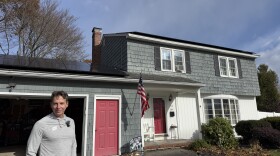When it’s dangerously hot outside, as it was this week with temperatures reaching into the upper 90s, many local governments spring into action – opening cooling centers and sharing information about the risks of extreme heat. But as the climate changes, how cities and towns plan for extreme heat may need to change, too.
New Hampshire is getting warmer, and days of extreme heat in the state are projected to become more frequent. The number of days every year with a heat index over 90 degrees has doubled since 1980, from 8 to 15, according to the state’s health department. And in a scenario where we continue to rely on fossil fuels, New Hampshire could see 50 to 60 days above 90 degrees each year by the end of the century.
For Kurt Blomquist, Keene’s assistant city manager, heat is a rising issue. He says like most cities in New England, Keene is set up well to support residents during cold weather emergencies, like ice or snow storms. But in the past, they haven’t had to deal with as much heat.
“What that's created is a lot of the buildings that are utilized for shelters typically do not have air conditioning,” he said.
The city has a public library, where people can cool off, and officials encourage residents to go to city pools. But their largest shelter space – the Parks and Recreation building – doesn’t have AC in its open spaces.
Blomquist said planners going forward will need to modify design standards created for a climate of the past, especially for buildings that can be used as shelters.
“If you look at, particularly, churches, larger community centers…many of them are 40, 50, 100 years old,” he said. “As buildings get modified, or new construction, making sure that we do build in conditioned air for summer months as part of any design or construction project.”
In Nashua, the city is working to find more organizations that can serve as cooling centers.
“We are seeing more hotter days, so to speak,” said Patrick Henry, Nashua’s public health emergency preparedness coordinator. “And we are actively having conversations again with those key partners in the city and also private and non-governmental agencies who assist with those cooling centers.”
The city is also starting to tell residents earlier in the year about how they can prepare for warm temperatures, conserve water, and stay safe if the power goes out, which can happen on hot days if the electricity grid gets overburdened.
Kim McNamara, the director of Portsmouth’s health department, said her team is also starting to talk about expanding access to cooling, in the form of “splash pads,” or small outdoor water parks. For some families, she said, getting to a pool or other cooling facility can be tough.
Heat is also felt differently in different parts of cities, due to the heat island effect. That often impacts historically marginalized communities more significantly. For example, some lower-income neighborhoods and communities of color often have fewer trees, which can mitigate heat.
“It would be great to have different areas of cooling spread throughout the city rather than concentrated at a single outdoor pool,” McNamara said. “Those types of things take planning and you have to set aside capital funds for that.”
Standing up cooling centers hasn’t been too much of a challenge in Lebanon, said fire chief Chris Christopoulos, but staffing could become difficult.
“We'll actually up-staff if we get to certain heat indexes over a number of days,” he said. “So that has certainly a budgetary impact.”
Many communities use state guidance to plan for extreme heat. New Hampshire’s most recent excessive heat emergency response plan is from 2014, and lays out how the state responds to different levels of extreme heat events.
Cities also communicate with the state about which cooling centers are open to the public; Granite Staters can find that information by calling 211.
Those cooling centers are vital, said Judy Taylor, the executive director of Area HomeCare, an agency that provides in-home care services to older adults and those with disabilities. But they don’t meet the needs of everyone.
Some local governments in other states have started programs to give away or help with the cost of air conditioning units for residents.
In New Hampshire, Taylor’s organization runs Project CoolAir, which is working to provide air conditioners for those at higher risk of heat illnesses, including older adults and people with chronic illnesses, in Rockingham County.
“A lot of the people that get our air conditioners are homebound or they certainly don't necessarily drive, or can't, once they get to a place, walk the distance to the local library,” she said.
As the state gets hotter, Taylor says, her program may need to change, too.
“Obviously the need is going to increase,” she said. “Hopefully the amount of people that won't be able to afford it doesn't increase as much.”








